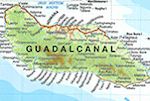Mbabanga
Village, Gizo Island
Photos
of Mbabanga Village
By
Richard Moore
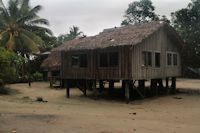 IT
WAS slightly painful, cute, a little bit awkward and
yet so endearing that meeting a kindergarten class in
a tiny, remote village of Mbabanga became one of the
highlights of a very eventful visit to the Solomon Islands.
IT
WAS slightly painful, cute, a little bit awkward and
yet so endearing that meeting a kindergarten class in
a tiny, remote village of Mbabanga became one of the
highlights of a very eventful visit to the Solomon Islands.
Through intermittently heavy rain we had walked for
about 20 minutes through jungle and tall coconut palm
plantations to get to the home of 300 islanders – a
clean and well laid out collection of pole huts and
buildings made from local hard wood and thatched palm
fronds.
Some homes had tin roofs using rusting corrugated iron.
We
came to Mbabanga to see life as it is for most Solomon
Islanders who live away from the big cities.
It was basic.
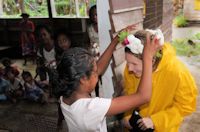 Fresh
water comes from tanks collecting rainwater and obtained
through a PVC pipe centrally placed like a modern-day
well.
Fresh
water comes from tanks collecting rainwater and obtained
through a PVC pipe centrally placed like a modern-day
well.
And
it probably wasn’t the right day to come as the skies
were grey, the sea was grey and well, it was humid and
very wet. But, when you are on a tight schedule, you
need to get out and about in all weathers and worry
later about finding a good cloth to dry off the camera
gear.
The
kindy was set in a thatched building with a split-level
floor.
On one side was a raised sandy area, while the classes
were held on the lower area on woven frond matting.
It was cool and decorative.
The
bottom half of the class’ walls was rough wood paneling
and the top sections open to the elements, although
sturdy wire grills served as places to hang class work.
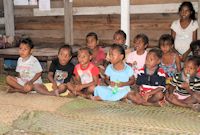 We
were welcomed at the door by Jacinta, the kindy teacher,
and given flower headwear by three of the little kids.
We
were welcomed at the door by Jacinta, the kindy teacher,
and given flower headwear by three of the little kids.
The
flowers were definitely not my cup of tea but to refuse
the offering would be rude and they did smell beautiful.
Then
we were treated to a song as the class introduced themselves
by each one singing: “My name is …. And I love the Lord.”
There
were 18 kids in the kindy class, although Jacinta confided
that a number of them were younger brothers and sisters
who came along to join in.
They
were aged between three and five, dressed in a variety
of clothes and colours and all had big dark eyes.
We took photos and – as a really good icebreaker we
discovered while touring the islands – we showed the
class the images on our digital devices. They crowded
around and their reactions were fun – all were delighted
to see themselves on an iPad or back of my camera.
It was probably the first time in their lives they’d
seen pictures of themselves.
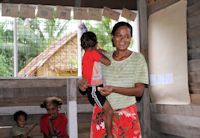 Once
Jacinta restored a bit or order – mainly among we visitors
– the class sang us some songs and did some dances.
Once
Jacinta restored a bit or order – mainly among we visitors
– the class sang us some songs and did some dances.
The
girls were very shy and did a cute, but unwiggly, version
of a native dance. The lads – boisterous even at that
age – did an energetic dance I took to be the local
challenge.
Then, dancing complete, it was time to go.
We
stood and my female travelling companions were farewelled
by the kids, but the young fellow designated to be my
“Goodbye Guy” burst into tears saying he was scared
of me.
Hardly
surprising as I was twice the size of the men in the
village and my shade of slighty-tanned pink I guess
is a bit of a rarity in these parts.
As
are children’s books and so I made a mental note that
upon my return home I would delve into my storage unit
and get a collection of suitable titles from the ones
I used to read to my kids and send them over to Jacinta
and her charges.
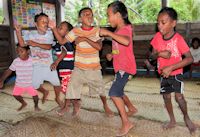 To
me they only contain memories, but for the island children
they could open their eyes to a different world … much
as those kids did for me.
To
me they only contain memories, but for the island children
they could open their eyes to a different world … much
as those kids did for me.
Acknowledgements:
Richard Moore stayed on Mbabanga Island courtesy of
Fatboys Resort and the Solomon Islands Visitors Bureau.
International and internal flights to Gizo Island were
provided by Solomons Airlines. Website www.visitsolomons.com.sb
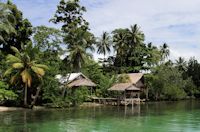
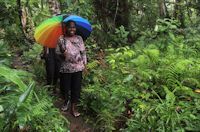
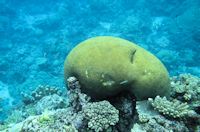
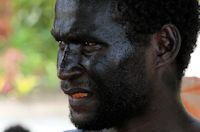

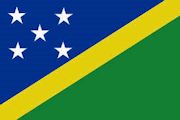
 IT
WAS slightly painful, cute, a little bit awkward and
yet so endearing that meeting a kindergarten class in
a tiny, remote village of Mbabanga became one of the
highlights of a very eventful visit to the Solomon Islands.
IT
WAS slightly painful, cute, a little bit awkward and
yet so endearing that meeting a kindergarten class in
a tiny, remote village of Mbabanga became one of the
highlights of a very eventful visit to the Solomon Islands. Fresh
water comes from tanks collecting rainwater and obtained
through a PVC pipe centrally placed like a modern-day
well.
Fresh
water comes from tanks collecting rainwater and obtained
through a PVC pipe centrally placed like a modern-day
well.  We
were welcomed at the door by Jacinta, the kindy teacher,
and given flower headwear by three of the little kids.
We
were welcomed at the door by Jacinta, the kindy teacher,
and given flower headwear by three of the little kids.
 Once
Jacinta restored a bit or order – mainly among we visitors
– the class sang us some songs and did some dances.
Once
Jacinta restored a bit or order – mainly among we visitors
– the class sang us some songs and did some dances.
 To
me they only contain memories, but for the island children
they could open their eyes to a different world … much
as those kids did for me.
To
me they only contain memories, but for the island children
they could open their eyes to a different world … much
as those kids did for me. 



